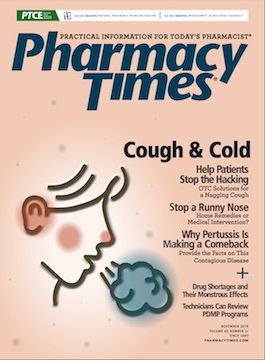Publication
Article
Pharmacy Times
When Is a "Whoop" Not a Cheer?
Pharmacists should understand the facts, misconceptions, and myths about pertussis.
Pertussis, an exceedingly contagious respiratory illness, is making a comeback. Also called whooping cough for its characteristic violent cough, pertussis makes it difficult to breathe, drink, or eat, and symptoms can last for 10 weeks or more. Young children can become severely dehydrated or develop heart failure or pneumonia because of pertussis.1,2 Before pertussis vaccines were available, up to 260,000 Americans contracted the disease annually, resulting in about 9000 deaths each year.
By the 1990s, the number of pertussis cases had dropped to just a few thousand.1,3 The figure shows, however, the disease has made a comeback in recent years.3 Pharmacists should be well versed in the misconceptions and myths associated with whooping cough to identify infection, prevent transmission, and treat appropriately.

MYTH 1: WHOOPING COUGH IS A CHILDHOOD DISEASE
Young children and teenagers are at highest risk of infection, but anyone can contract and spread pertussis. In 2010, the CDC reported an increase in pertussis diagnosis among children aged 7 to 10 years. Since then, the agency has also observed an increase in cases among teens.4 The CDC recommends vaccinating babies starting at 2 months. Five doses of the diphtheria, tetanus, and acellular pertussis (DTaP) vaccine are necessary for children to build immunity against whooping cough.2
Adults are at risk even if they were vaccinated as children, so pharmacists should recommend revaccination when appropriate, especially those who have contact with babies younger than 12 months. Weakening immunity in aging adults and a growing population of unvaccinated children have contributes to the growing number of cases.3
MYTH 2: IT CANNOT BE WHOOPING COUGH IF THE PERSON HAS BEEN IMMUNIZED OR HAS HAD PERTUSSIS
Pertussis epidemics in 2005, 2010, and 2012 show that protection from adolescent and childhood DTaP vaccines is short-lived. Immunity appears to wane after 10 years, leaving young adults and new parents susceptible to infection if they are not re-vaccinated. They also can transmit pertussis to others, especially infants.5,6 Pharmacists should encourage pregnant women and their close contacts or families to consider a tetanus, diphtheria, and pertussis (TdaP) booster to protect the newborn baby and themselves.
Research confirms that protective immunity from pertussis infection is not lifelong. Following natural infection, immunity wanes after 7 to 20 years.5,7 Health care providers should not rule out pertussis based on previous infection and should recommend TdaP boosters even in those previously infected. Additionally, vaccinated children can develop pertussis (DTaP vaccine failure), although their symptoms will be milder than those experienced by unvaccinated children.5 Pharmacists should stress this point to parents who are reluctant to vaccinate their children.
MYTH 3: ANTIBIOTICS AND COUGH MEDICINE RESOLVE ALL CASES OF PERTUSSIS
Pertussis is caused by Bordetella pertussis (table 17-9), bacteria that live in the mouth, nose, and throat. Patients who have pertussis are contagious from the beginning of the catarrhal stage (similar to common cold symptoms) through the third week of coughing or before 5 days of antimicrobial treatment. The earlier treatment is initiated the better. Treatment after 3 weeks of illness is unlikely to help. By this point, bacteria have left the body, but symptoms will likely remain because of existing damage.8

Postexposure antimicrobial prophylaxis (PEP) can protect close contacts of patients with pertussis at increased risk of severe disease from death or serious complications. The CDC supports the following9:
- Providing PEP to all household contacts of a patient with pertussis within 21 days of cough onset in the original patient. Secondary illness in household contacts is common, even when those individuals are immunized.
- Providing PEP to high-risk people within 21 days of exposure to an infectious patient with pertussis. These high-risk groups include infants, people with preexisting medical conditions that may be exacerbated (asthma, immunocompromised, etc), women in the third trimester of pregnancy, and individuals who have close contact with infants or pregnant women.
Pharmacists should not recommend cough medicine in patients younger than 4 years. Instead, they should recommend the actions described in table 2.8

CONCLUSION
Pharmacists can watch for inappropriate antibiotic and cough medicine use in pertussis and recommend appropriate therapies to increase the likelihood that close contacts receive the care and prophylactic treatment they need.
Kelsey Giara is a freelance writer based in New Hampshire.Jeannette Y. Wick, RPh, MBA, FASCP, is the assistant director of the Office of Pharmacy Professional Development at the University of Connecticut School of Pharmacy in Storrs.
REFERENCES
- Before the age of vaccination. Pittsburgh-Post Gazette. October 31, 2000. old. post-gazette.com/healthscience/20001031hvaccines.asp. Accessed August 28, 2019.
- Editorial staff. Five things to know about whooping cough. American Lung Association website. lung.org/about-us/blog/2019/01/whooping-cough.html. Published January 10, 2019. Accessed August 15, 2019.
- Pertussis cases by year (1922-2015). CDC website. cdc.gov/pertussis/surv-report- ing/cases-by-year.html. Updated August 7, 2017. Accessed August 15, 2019.
- Pertussis (whooping cough): fast facts. CDC website. cdc.gov/pertussis/fast-facts. html. Updated August 7, 2017. Accessed August 15, 2019.
- Cherry JD. Pertussis and immunizations: facts, myths, and misconceptions. American Academy of Pediatrics, California website. aap-ca.org/pertussis-and-im- munizations-facts-myths-and-misconceptions/. Published May 12, 2014. Accessed August 15, 2019.
- Dajani NA, Scheifele D. How long can we expect pertussis protection to last after the adolescent booster dose of tetanus-diphtheria-pertussis (Tdap) vaccines? Paediatr Child Health. 2007;12(10):873-874.
- Wendelboe AM, Van Rie A, Salmaso S, Englund JA. Duration of immunity against pertussis after natural infection or vaccination. Pediatr Infect Dis J. 2005;24(suppl 5):S58-S61.
- Pertussis (whooping cough): diagnosis and treatment. CDC website. cdc.gov/ pertussis/about/diagnosis-treatment.html. Updated August 7, 2017. Accessed August 15, 2019.
- CDC for Disease Control and Prevention. Postexposure antimicrobial prophylaxis: information for health professionals. https://www.cdc.gov/pertussis/outbreaks/pep. html. Updated August 7, 2017. Accessed August 15, 2019.







